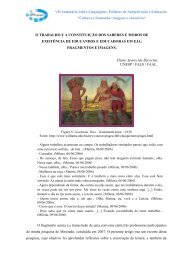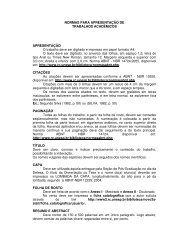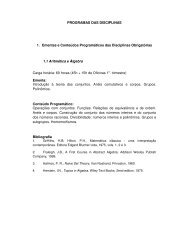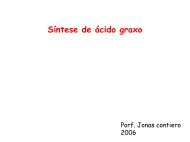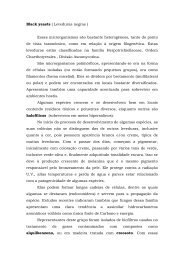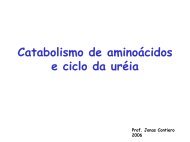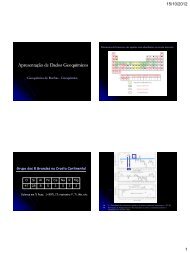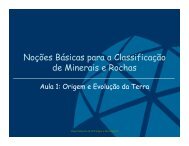Diet and Spatial Pattern of Foraging in Ectatomma opaciventre ...
Diet and Spatial Pattern of Foraging in Ectatomma opaciventre ...
Diet and Spatial Pattern of Foraging in Ectatomma opaciventre ...
Create successful ePaper yourself
Turn your PDF publications into a flip-book with our unique Google optimized e-Paper software.
T<strong>of</strong>olo, V.C. et al. — <strong>Spatial</strong> <strong>Pattern</strong> <strong>of</strong> <strong>Forag<strong>in</strong>g</strong> <strong>in</strong> E. <strong>opaciventre</strong><br />
The forag<strong>in</strong>g trails presented a s<strong>in</strong>uous pattern from the beg<strong>in</strong>n<strong>in</strong>g to the end,<br />
with directional fidelity (Fig. 2). The pathways from nest 1 were concentrated<br />
around the nest along the north-south axis; <strong>in</strong> nest 2, they were distributed<br />
southeast <strong>and</strong> northwest to the nest; <strong>and</strong> <strong>in</strong> nest 3, they were west-oriented.<br />
Thus, the foragers were spatially distributed <strong>in</strong> the forag<strong>in</strong>g area so as to avoid<br />
overlap with the trails from neighbor<strong>in</strong>g colonies. These areas were explored<br />
repeatedly, demonstrat<strong>in</strong>g the preference <strong>of</strong> colonies for specific regions <strong>in</strong><br />
the forag<strong>in</strong>g arena. In the 3 colonies, most trajectories were close to the nest,<br />
with few pathways more than two meters away from it.<br />
<strong>Diet</strong> <strong>and</strong> forag<strong>in</strong>g effort<br />
Dur<strong>in</strong>g the observation period, few foragers left the nest <strong>in</strong> search <strong>of</strong> food<br />
resources. The workers <strong>of</strong> E. <strong>opaciventre</strong> left the nest on average 5.4 ± 2.7 (SD)<br />
times per forag<strong>in</strong>g hour, return<strong>in</strong>g almost at the same rate, 4.9 ± 2.5 (SD)<br />
times. Of the 371 forag<strong>in</strong>g trips recorded, only 9.16% ended with the workers<br />
return<strong>in</strong>g with prey. Liquid food was not observed <strong>in</strong> the m<strong>and</strong>ibles <strong>of</strong> the<br />
foragers, only solids. The description <strong>of</strong> the prey captured is shown <strong>in</strong> Table<br />
2. Over half <strong>of</strong> the prey items collected (52.78%) belonged to Formicidae,<br />
<strong>in</strong>clud<strong>in</strong>g an <strong>in</strong>dividual <strong>of</strong> the same genus, E. brunneum. All the prey were<br />
collected <strong>in</strong>dividually except a chrysalis <strong>of</strong> Lepidoptera for which there was a<br />
recruitment strategy known as social facilitation. In this event, an <strong>in</strong>dividual<br />
recruited a nestmate to collect the prey item without us<strong>in</strong>g a scent trail. As<br />
the prey was too large <strong>and</strong> fixed to the substrate by silk threads, the forager<br />
quickly returned to the nest <strong>and</strong> then left, followed by another ant. The<br />
recruited ant followed the recruiter to the food source <strong>and</strong> both cut the silk<br />
threads to collect <strong>and</strong> transport the food item to the nest.<br />
DISCUSSION<br />
The diet <strong>of</strong> E. <strong>opaciventre</strong> was narrow, probably because the nests were<br />
located <strong>in</strong> a degraded area <strong>and</strong> the research was carried out <strong>in</strong> the dry season.<br />
In the Brazilian savannah (Cerrado), Pie (2004) observed that, <strong>in</strong> 50% <strong>of</strong> the<br />
cases, the diet <strong>of</strong> E. <strong>opaciventre</strong> is composed <strong>of</strong> termites, <strong>and</strong> over 20% <strong>of</strong> the<br />
other prey consists <strong>of</strong> other ants, ma<strong>in</strong>ly those <strong>of</strong> the genus Atta.<br />
Wheeler (1986) analyzed the diet <strong>of</strong> E. tuberculatum <strong>in</strong> Panama, also us<strong>in</strong>g<br />
the method <strong>of</strong> collect<strong>in</strong>g prey items that workers carried to the nest. Insects<br />
611




